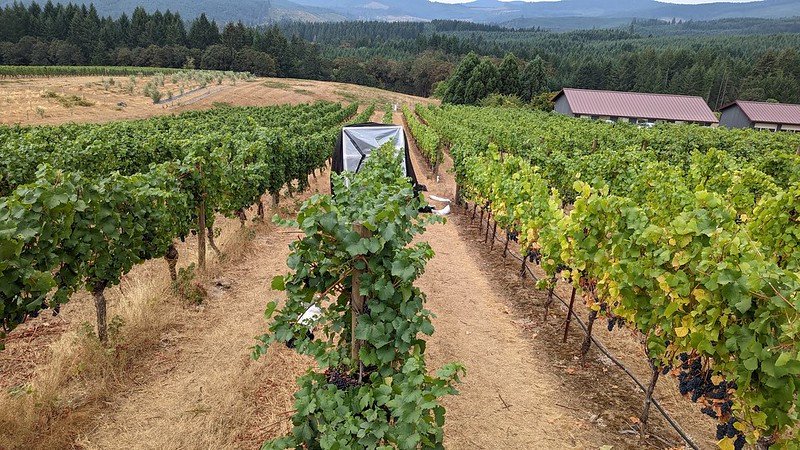OSU researchers say spray coating for vineyard grapes shows promise in battle between wildfire smoke and wine

CORVALLIS, Ore. (KTVZ) – Spray-on coatings for grapes in the vineyard have promise in preventing off flavors in wines that result from contact with wildfire smoke, according to new Oregon State University research announced Monday.
Oregon State researchers are developing a product that vineyard managers could spray onto their grapes to protect from wildfire smoke before it reaches their vines. The researchers expect to have a spray coating to prevent smoke damage available in the next several years.
“Wildfire smoke is an increasing problem for wineries in the United States and around the world, and right now, vineyard managers really have no tools to manage the effects of the smoke,” said Elizabeth Tomasino, an associate professor of enology at Oregon State. “This coating has the potential to transform the wine industry.”
The research was prompted by wildfire smoke that enveloped much of Oregon, Washington, California and British Columbia in September 2020 and significantly impacted wine grape quality.
The fires coincided with the harvest time for grapes. At the time, vineyard managers were unsure of the impact of wildfire smoke on their crop and as a result many decided the uncertainty wasn’t worth the cost to harvest their grapes and potential impact on wine quality.
The smoke event resulted in more than $3 billion in losses for the wine industry.
In a paper recently published in the Journal of Agricultural and Food Chemistry, Oregon State researchers, led by Yanyun Zhao, targeted three compounds known as volatile phenols that contribute to smoke taint in grapes.
Zhao, a university distinguished professor who has studied food coatings for more than 20 years, and Jooyeoun Jung, a senior researcher assistant professor in Zhao’s lab, developed cellulose nanofiber-based coatings containing chitosan and beta-cyclodextrin that can be applied to grapes in the vineyard.
The work showed that depending on the formulations, the films can block guaicol and syringol and capture meta-cresol, wildfire smoke compounds that when absorbed by wine grapes result in off-flavors in wine.
The difference between blocking and capturing is important, Zhao said. Blocking means the coating doesn’t absorb the phenol compounds and wouldn’t need to be washed off before winemaking. Capturing means the coating absorbs the compounds and would need to be washed off.
“Not having to wash it off saves time, money and water for grape growers,” Zhao said. “That is what we are aiming for.”
Developing the coatings is challenging because the phenols have different chemical shapes, the researchers note, making it difficult to create a coating that adheres properly to all the shapes to block the smoke. The researchers are continuing to refine the coating formulations and perform cost analysis studies.
Their two years of coating application studies in the vineyard at Oregon State’s Southern Oregon Research and Extension Center in Central Point, Oregon found that the coatings do not impact the growth and quality of the grapes.
The coatings were also applied at Oregon State University’s Woodhall Vineyard outside Monroe, Oregon, where smoke chambers were placed over vines to test the smoke-blocking ability of the coatings. Wine from these grapes is currently being analyzed for quality attributes.
“Growers want something they can spray on their vines to protect them,” said Alexander Levin, a viticulturist who is the director of the Southern Oregon Research and Extension Center. “If this becomes a commercially available thing it’s going to be a big game-changer.”
In addition to Tomasino, Zhao, Jung and Levin, the paper is authored by Trung Tran, Lindsay Garcia, Joseph Deshields, Cole Cerrato and Michael Penner, all of Oregon State.
The work is funded by the Oregon Department of Agriculture Specialty Crop Block Grant and the U.S. Department of Agriculture Specialty Crop Grant.
About the OSU College of Agricultural Sciences: Through its world-class research on agriculture and food systems, natural resource management, rural economic development and human health, the College provides solutions to Oregon’s most pressing challenges and contributes to a sustainable environment and a prosperous future for Oregonians.